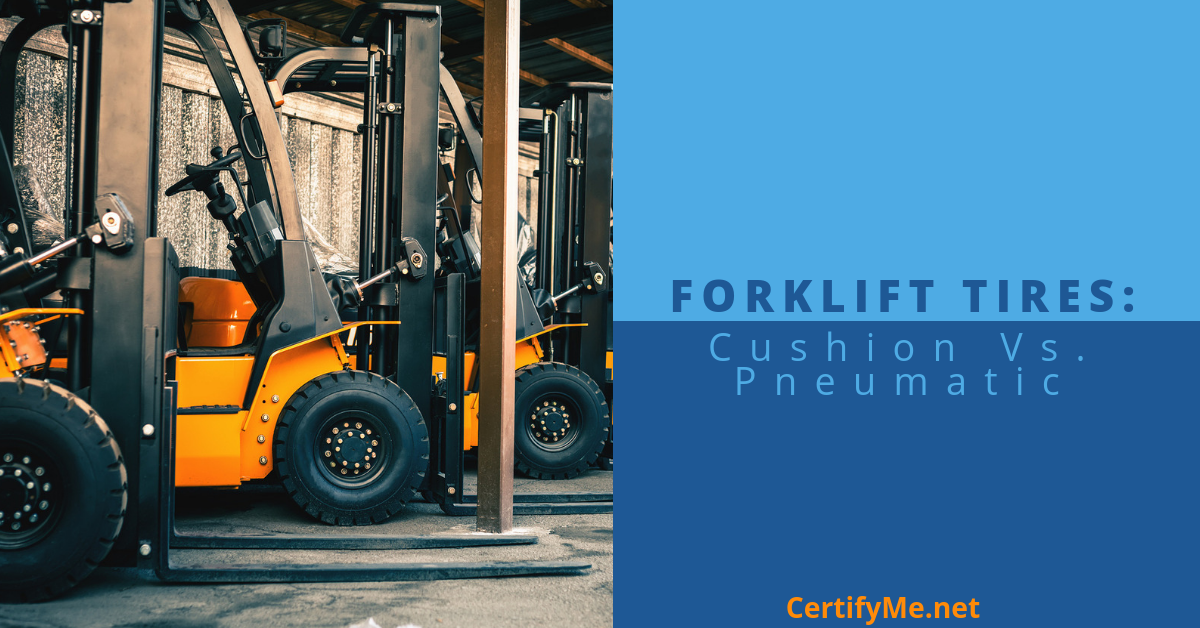Pneumatic Forklift Tires vs Cushion Tires: Types, Benefits, and Safety Tips
Posted by: admin on April 21, 2025
 Selecting the right tires for a forklift directly impacts safety, efficiency, and equipment longevity. Businesses that operate forklifts outdoors or across rough terrain rely heavily on pneumatic tires, while cushion tires offer advantages in smooth, indoor settings. Choosing properly between these options ensures better handling, lower maintenance costs, and improved operator safety.
Selecting the right tires for a forklift directly impacts safety, efficiency, and equipment longevity. Businesses that operate forklifts outdoors or across rough terrain rely heavily on pneumatic tires, while cushion tires offer advantages in smooth, indoor settings. Choosing properly between these options ensures better handling, lower maintenance costs, and improved operator safety.
Why Forklift Tire Selection Matters
Tires serve as the critical connection between the forklift and the ground. Matching tire type to the work environment prevents excessive wear, improves traction, and enhances stability. Forklifts that operate on indoor floors benefit from different tire designs compared to machines navigating gravel, asphalt, or construction sites. Understanding these differences saves money and reduces downtime.
What Are Pneumatic Forklift Tires?
Pneumatic forklift tires come in two main varieties: air-filled and solid rubber. Air-filled pneumatic tires resemble automobile tires, offering a cushioned ride and strong shock absorption. Solid pneumatic tires, on the other hand, provide the same durability without the risk of punctures. Industries such as lumber yards, shipping docks, and warehouses with uneven surfaces commonly rely on pneumatic tires to manage outdoor, rugged conditions.
Solid Pneumatic Forklift Tires Explained
Solid pneumatic forklift tires differ from air-filled models by eliminating the hollow core, creating a puncture-proof solid rubber construction. This design significantly reduces the risk of tire failure on debris-laden worksites. Solid pneumatic tires extend lifespan and minimize maintenance concerns while sacrificing a small amount of ride comfort compared to air-filled versions.
Cushion vs Pneumatic Forklift Tires
Choosing between cushion and pneumatic tires depends heavily on the operating environment. Cushion tires, made of smooth rubber and fitted directly onto the wheel, excel indoors where surfaces are even and clean. Pneumatic tires, by contrast, tackle outdoor areas, rough concrete, dirt lots, and uneven loading zones better. Cushion tire forklifts feature smaller frames, allowing them to maneuver tight warehouse aisles more easily. Pneumatic tire models require larger frames but offer better ground clearance and stability outdoors. Cost, maintenance needs, and wear rates differ between the two, making the right choice crucial.
Forklift Pneumatic Tire Maintenance Tips
Regular inspections maintain pneumatic tire safety and performance. Operators should check for:
- Tread Wear: Monitor depth and evenness across tires.
- Cracks and Damage: Look for cuts, bulges, and embedded debris.
- Air Pressure (Air-Filled Pneumatics): Maintain manufacturer-recommended pressure levels.
- Flat Spots: Detect early to prevent unsafe operating conditions.
Foam-filled pneumatic tires offer an alternative for sites where punctures are common. These reduce downtime and eliminate air pressure concerns while retaining much of the ride comfort.
Forklift Tire Safety Best Practices
Operating forklifts with damaged or worn-out tires creates serious hazards. Safe practices include:
- Tread Inspections: Perform daily walkarounds to check for issues.
- Replacement Timing: Swap tires showing excessive wear before accidents happen.
- Compliance Reviews: Ensure tires meet OSHA safety regulations to avoid violations and fines.
FAQs About Pneumatic Forklift Tires
What Is a Pneumatic Forklift Tire Made Of?
Pneumatic tires are typically made from a blend of synthetic rubber compounds, reinforced with layers of fabric or steel for durability.
How Long Do Pneumatic Forklift Tires Last?
Tire lifespan varies by usage, environment, and maintenance but typically ranges from 2,000 to 2,400 operating hours.
Can You Repair Punctured Forklift Tires?
Minor punctures in air-filled tires may be repairable. Solid pneumatic tires usually require full replacement when damaged.
Do Solid Pneumatic Tires Ride Rougher Than Air-Filled Ones?
Solid pneumatic tires offer less cushioning compared to air-filled models, but many operators find the tradeoff acceptable for the improved durability.
Keep Your Forklift Safe with CertifyMe
CertifyMe’s OSHA-compliant forklift training includes tire safety best practices, daily inspection tips, and maintenance guidance to extend equipment life. Operators gain essential knowledge that reduces workplace accidents and lowers repair costs. Complete your training online anytime, earn OSHA certification fast, and enjoy free three-year renewals with CertifyMe.
Welcome to CertifyMe.net
CertifyMe.net has offered online forklift certification since 1999. With Our Convenient online program. your employess can earn their certification in an hour or less.
Browse Online Certifications:
This low-cost program can be compeleted anytime, anywhere!






